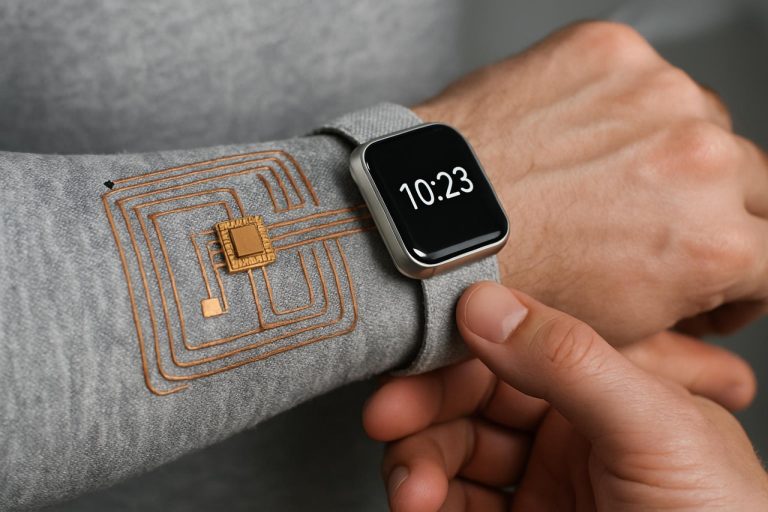
Textile-Based Flexible Electronics Market Report 2025: In-Depth Analysis of Growth, Innovation, and Global Trends. Explore Market Drivers, Competitive Dynamics, and Future Opportunities in Smart Textiles.
- Executive Summary & Market Overview
- Key Technology Trends in Textile-Based Flexible Electronics
- Competitive Landscape and Leading Players
- Market Growth Forecasts (2025–2030): CAGR, Revenue, and Volume Analysis
- Regional Analysis: Key Markets and Emerging Regions
- Challenges, Risks, and Opportunities in the Industry
- Future Outlook: Innovation Pathways and Strategic Recommendations
- Sources & References
Executive Summary & Market Overview
Textile-based flexible electronics represent a rapidly evolving segment at the intersection of advanced materials, wearable technology, and smart textiles. These systems integrate electronic components—such as sensors, actuators, and conductive circuits—directly into fabrics, enabling functionalities like health monitoring, energy harvesting, and interactive interfaces. The global market for textile-based flexible electronics is poised for significant growth, driven by increasing demand in healthcare, sports, military, and consumer electronics sectors.
According to IDTechEx, the e-textiles market, which encompasses textile-based flexible electronics, is projected to surpass $3 billion by 2025, with a compound annual growth rate (CAGR) exceeding 20%. This expansion is fueled by advancements in conductive fibers, miniaturized sensors, and flexible power sources, as well as growing consumer interest in wearable health and fitness devices. Major industry players, including Textronics Inc., Interactive Wear AG, and Sensoria Health, are investing heavily in research and development to enhance product durability, washability, and user comfort.
Healthcare remains the dominant application area, with textile-based flexible electronics enabling continuous physiological monitoring, remote diagnostics, and rehabilitation support. The COVID-19 pandemic accelerated adoption of remote health monitoring solutions, further boosting market momentum. In sports and fitness, smart garments equipped with motion and biometric sensors are gaining traction among professional athletes and consumers alike. Military and defense sectors are also adopting these technologies for soldier health monitoring and situational awareness.
Geographically, North America and Europe lead in terms of innovation and market adoption, supported by robust R&D ecosystems and early consumer uptake. However, Asia-Pacific is expected to witness the fastest growth through 2025, driven by expanding manufacturing capabilities and rising investments in smart textile infrastructure, particularly in China, Japan, and South Korea (MarketsandMarkets).
- Market size (2025): Projected to exceed $3 billion globally
- Key drivers: Healthcare demand, wearable tech adoption, material innovations
- Leading regions: North America, Europe, rapid growth in Asia-Pacific
- Major players: Textronics Inc., Interactive Wear AG, Sensoria Health
In summary, textile-based flexible electronics are set to transform multiple industries by 2025, with robust growth prospects underpinned by technological innovation and expanding application areas.
Key Technology Trends in Textile-Based Flexible Electronics
Textile-based flexible electronics are at the forefront of innovation in wearable technology, smart clothing, and next-generation medical devices. As of 2025, several key technology trends are shaping the development and commercialization of these advanced materials, driven by the convergence of textile engineering, electronics miniaturization, and materials science.
- Integration of Conductive Fibers and Yarns: The use of conductive fibers—such as silver-coated, carbon-based, and graphene-infused yarns—has become increasingly prevalent. These materials enable the seamless embedding of sensors, circuits, and energy storage devices directly into fabrics, enhancing durability and washability. Companies like Textronics Inc. and Interactive Wear AG are leading the way in commercializing such smart textiles.
- Advancements in Printing and Coating Techniques: Digital printing and advanced coating methods, including inkjet and screen printing of conductive inks, are enabling high-resolution, flexible electronic patterns on textiles. This trend supports mass customization and scalability, as highlighted in recent reports by IDTechEx.
- Energy Harvesting and Storage Integration: The development of flexible, textile-based batteries and energy harvesting systems (such as triboelectric and piezoelectric generators) is a major trend. These innovations allow wearables to be self-powered, reducing reliance on external batteries. Research from Fraunhofer Society demonstrates significant progress in integrating these systems into garments.
- Enhanced Biocompatibility and Comfort: New materials and fabrication techniques are improving the comfort, breathability, and skin compatibility of electronic textiles. The use of stretchable substrates and encapsulation methods ensures that electronics do not compromise the tactile qualities of fabrics, a focus area for companies like Hexoskin.
- Data Connectivity and IoT Integration: Textile-based electronics are increasingly designed with wireless communication modules (Bluetooth, NFC, Wi-Fi) for seamless integration with smartphones and cloud platforms. This trend is accelerating the adoption of smart clothing in health monitoring, sports, and military applications, as noted by Gartner.
These technology trends are collectively driving the textile-based flexible electronics market toward greater functionality, user acceptance, and commercial viability in 2025 and beyond.
Competitive Landscape and Leading Players
The competitive landscape of the textile-based flexible electronics market in 2025 is characterized by a dynamic mix of established electronics manufacturers, innovative textile companies, and specialized startups. The sector is witnessing increased collaboration between traditional textile producers and electronics firms, aiming to integrate advanced functionalities such as sensing, energy harvesting, and connectivity into fabrics. This convergence is driving rapid innovation and intensifying competition.
Key players in this market include Samsung Electronics, which has invested in smart garment prototypes and flexible display technologies, and Textronics Inc., a pioneer in integrating sensors into textiles for sports and health monitoring applications. Interactive Wear AG is another notable company, focusing on wearable electronics for industrial and military use, offering solutions that combine durability with advanced electronic integration.
Startups such as Hexoskin and Sensoria Health are gaining traction by developing smart clothing with embedded biometric sensors, targeting healthcare and fitness markets. These companies leverage proprietary sensor technologies and data analytics platforms to differentiate their offerings. Meanwhile, DuPont and W. L. Gore & Associates are leveraging their expertise in advanced materials to supply conductive fibers and flexible substrates, which are critical components for textile-based electronics.
- Strategic Partnerships: The market is marked by strategic alliances, such as collaborations between Adidas and technology firms to develop smart sportswear, and between Levi Strauss & Co. and Google ATAP for the Jacquard project, which embeds touch-sensitive fibers into denim jackets.
- Geographic Leadership: North America and Europe remain at the forefront, driven by strong R&D ecosystems and consumer demand for wearable technology. However, Asia-Pacific players, particularly in Japan and South Korea, are rapidly scaling up production and innovation.
- Barriers to Entry: High R&D costs, intellectual property challenges, and the need for robust supply chains pose significant barriers for new entrants, favoring established players with deep technical expertise and financial resources.
Overall, the textile-based flexible electronics market in 2025 is highly competitive, with leadership determined by innovation, material science capabilities, and the ability to form cross-industry partnerships that accelerate commercialization and adoption.
Market Growth Forecasts (2025–2030): CAGR, Revenue, and Volume Analysis
The textile-based flexible electronics market is poised for robust growth between 2025 and 2030, driven by increasing demand for wearable technology, advancements in smart textiles, and expanding applications across healthcare, sports, and military sectors. According to projections by MarketsandMarkets, the global market for textile-based flexible electronics is expected to register a compound annual growth rate (CAGR) of approximately 25% during this period. This rapid expansion is underpinned by the integration of electronic components such as sensors, actuators, and energy storage devices into fabrics, enabling new functionalities and user experiences.
Revenue forecasts indicate that the market, valued at around USD 2.5 billion in 2025, could surpass USD 7.5 billion by 2030, reflecting both increased adoption and higher average selling prices for advanced textile-based electronic products. The healthcare segment is anticipated to be a major revenue contributor, with smart garments for patient monitoring and rehabilitation driving significant uptake. Similarly, the sports and fitness sector is projected to see strong volume growth, as athletes and consumers increasingly seek real-time biometric tracking and performance analytics through embedded textile sensors.
Volume analysis suggests that unit shipments of textile-based flexible electronics will grow in tandem with revenue, with annual production expected to reach over 100 million units by 2030. This surge is facilitated by improvements in manufacturing processes, such as roll-to-roll printing and conductive yarn development, which are reducing costs and enabling mass production. Key players like DuPont, Textronics, and Hexoskin are investing heavily in R&D to enhance product durability, washability, and integration with wireless communication technologies.
- Regional Outlook: Asia-Pacific is expected to lead market growth, driven by strong textile manufacturing infrastructure and rising consumer electronics demand in countries such as China, Japan, and South Korea. North America and Europe will also see significant growth, particularly in medical and defense applications.
- Key Growth Drivers: Miniaturization of electronic components, consumer preference for unobtrusive wearable devices, and supportive government initiatives for smart healthcare and defense modernization.
- Challenges: High initial costs, technical challenges in durability and washability, and regulatory hurdles in medical applications may temper growth in certain segments.
Overall, the 2025–2030 period is set to witness accelerated adoption and innovation in textile-based flexible electronics, with strong market fundamentals supporting sustained double-digit growth rates.
Regional Analysis: Key Markets and Emerging Regions
The regional landscape for textile-based flexible electronics in 2025 is characterized by a dynamic interplay between established innovation hubs and rapidly emerging markets. The Asia-Pacific region continues to dominate both production and consumption, driven by robust manufacturing ecosystems, government support, and a burgeoning consumer electronics sector. China, in particular, leads the market, leveraging its advanced textile industry and significant investments in smart wearable technologies. According to IDTechEx, China’s share of the global e-textiles market is expected to exceed 40% by 2025, with major contributions from companies integrating flexible sensors and conductive fibers into apparel and medical devices.
Japan and South Korea are also pivotal, focusing on high-value applications such as healthcare monitoring and sports performance wearables. These countries benefit from strong R&D infrastructure and collaborations between electronics giants and textile manufacturers. For instance, South Korea’s Samsung Electronics and Japan’s Toray Industries are actively developing textile-based sensors and smart fabrics, targeting both domestic and international markets.
In North America, the United States remains a key innovator, particularly in the integration of flexible electronics into military uniforms, medical textiles, and fitness apparel. The presence of leading research institutions and startups, supported by funding from agencies such as the Defense Advanced Research Projects Agency (DARPA), accelerates commercialization. The U.S. market is also characterized by strong demand for advanced wearables and a growing focus on remote health monitoring, which is expected to drive further adoption of textile-based flexible electronics.
Europe is emerging as a significant player, with Germany, the UK, and France investing in sustainable and high-performance e-textiles. The European Union’s emphasis on circular economy principles and eco-friendly materials is fostering innovation in biodegradable conductive fibers and recyclable smart garments. Initiatives like the Horizon Europe program are channeling resources into collaborative projects that bridge the gap between textile engineering and electronics.
Emerging regions, notably Southeast Asia and India, are witnessing increased activity due to rising consumer awareness and the expansion of local manufacturing capabilities. These markets are expected to see accelerated growth as global brands seek cost-effective production bases and as domestic demand for smart textiles rises, particularly in healthcare and sports applications.
Challenges, Risks, and Opportunities in the Industry
The textile-based flexible electronics industry is poised for significant growth in 2025, but it faces a complex landscape of challenges, risks, and opportunities. As the integration of electronic components into fabrics accelerates, several key factors will shape the sector’s trajectory.
Challenges and Risks
- Manufacturing Complexity: Achieving reliable integration of conductive materials and electronic circuits into textiles remains a technical hurdle. Issues such as maintaining fabric flexibility, washability, and durability while embedding sensors or conductive threads are ongoing concerns. Inconsistent performance and high defect rates can impede large-scale commercialization (IDTechEx).
- Standardization and Regulation: The lack of industry-wide standards for safety, interoperability, and performance creates uncertainty for manufacturers and end-users. Regulatory frameworks are still evolving, particularly regarding biocompatibility and environmental impact, which can delay product launches (IEEE).
- Supply Chain Vulnerabilities: The industry relies on specialized materials such as conductive polymers, nanomaterials, and advanced fibers. Disruptions in the supply chain, whether due to geopolitical tensions or raw material shortages, can significantly impact production timelines and costs (McKinsey & Company).
- Market Adoption: Consumer skepticism regarding durability, comfort, and privacy of wearable electronics can slow adoption rates. Additionally, the higher cost of textile-based electronics compared to traditional textiles may limit market penetration, especially in price-sensitive segments (Grand View Research).
Opportunities
- Healthcare and Medical Applications: There is strong demand for smart textiles in remote patient monitoring, rehabilitation, and chronic disease management. Textile-based sensors can provide continuous, non-invasive health data, opening new revenue streams (MarketsandMarkets).
- Sports and Fitness: The integration of biometric sensors into athletic wear is gaining traction, offering real-time performance analytics and injury prevention tools for both professional and consumer markets.
- Defense and Safety: Military and first responder sectors are investing in smart uniforms with embedded communication, health monitoring, and environmental sensing capabilities, driving innovation and early adoption.
- Sustainability: Advances in biodegradable and recyclable electronic materials present opportunities to address environmental concerns, potentially differentiating products in a crowded market.
In summary, while textile-based flexible electronics face notable technical and market risks in 2025, the sector’s opportunities—particularly in healthcare, sports, and defense—are expected to drive continued investment and innovation.
Future Outlook: Innovation Pathways and Strategic Recommendations
The future outlook for textile-based flexible electronics in 2025 is shaped by rapid innovation, evolving consumer demands, and strategic industry realignments. As the convergence of textiles and electronics accelerates, several innovation pathways are emerging, driven by advances in materials science, miniaturization, and integration techniques. The market is expected to benefit from the proliferation of smart wearables, healthcare monitoring devices, and interactive fashion, with global revenues for smart textiles projected to surpass $5.5 billion by 2025, according to IDTechEx.
Key innovation pathways include the development of conductive fibers and yarns that maintain flexibility and durability during repeated use and washing. Companies are investing in scalable manufacturing processes, such as roll-to-roll printing and 3D knitting, to enable mass production without compromising performance. The integration of energy harvesting and storage components—such as flexible batteries and solar cells—directly into fabrics is another critical area, enabling self-powered smart garments for continuous health and activity monitoring. Research institutions and industry leaders are also exploring biodegradable and recyclable electronic textiles to address sustainability concerns, a trend highlighted in recent reports by Frost & Sullivan.
Strategically, companies should prioritize cross-sector collaborations, particularly with healthcare, sports, and defense industries, to co-develop application-specific solutions. Partnerships with technology providers and textile manufacturers can accelerate the commercialization of prototypes and reduce time-to-market. Intellectual property management will be crucial, as the field is characterized by rapid patent filings and competitive innovation. Firms are advised to invest in robust testing and certification processes to meet regulatory standards, especially for medical and safety-critical applications.
To capture emerging opportunities, market players should:
- Expand R&D efforts in multifunctional textiles that combine sensing, actuation, and communication capabilities.
- Leverage data analytics and AI to enhance the value proposition of smart garments, particularly in personalized healthcare and fitness.
- Monitor evolving consumer preferences for comfort, aesthetics, and sustainability, integrating these insights into product design.
- Engage with standardization bodies, such as the International Organization for Standardization (ISO), to shape and anticipate regulatory frameworks.
In summary, the 2025 landscape for textile-based flexible electronics will be defined by technological breakthroughs, strategic alliances, and a focus on user-centric, sustainable innovation. Companies that align their strategies with these trends are poised to lead in this dynamic and expanding market.
Sources & References
- IDTechEx
- Interactive Wear AG
- MarketsandMarkets
- Interactive Wear AG
- Fraunhofer Society
- DuPont
- W. L. Gore & Associates
- Levi Strauss & Co.
- Google ATAP
- Defense Advanced Research Projects Agency (DARPA)
- Horizon Europe
- IEEE
- McKinsey & Company
- Grand View Research
- Frost & Sullivan
- International Organization for Standardization (ISO)



